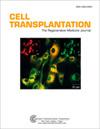Hematopoietic Stem Cell Transplantation in Sickle Cell Disease: A Multidimentional Review
IF 3.2
4区 医学
Q3 CELL & TISSUE ENGINEERING
引用次数: 0
Abstract
While exagamglogene autotemcel (Casgevy) and lovotibeglogene autotemcel (Lyfgenia) have been approved by the US Food and Drug Administration (FDA) as the first cell-based gene therapies for the treatment of patients 12 years of age and older with sickle cell disease (SCD), this treatment is not universally accessible. Allogeneic hematopoietic stem cell transplant (HSCT) has the potential to eradicate the symptoms of patients with SCD, but a significant obstacle in HSCT for SCD is the availability of suitable donors, particularly human leukocyte antigen (HLA)-matched related donors. Furthermore, individuals with SCD face an elevated risk of complications during stem cell transplantation due to SCD-related tissue damage, endothelial activation, and inflammation. Therefore, it is imperative to consider optimal conditioning regimens and investigate HSCT from alternative donors. This review encompasses information on the use of HSCT in patients with SCD, including the indications for HSCT, conditioning regimens, alternative donors, and posttransplant outcomes.镰状细胞病的造血干细胞移植:多学科综述
虽然美国食品和药物管理局(FDA)已经批准了exagamglogene autotemcel(Casgevy)和lovotibeglogene autotemcel(Lyfgenia)作为第一种基于细胞的基因疗法,用于治疗12岁及以上的镰状细胞病(SCD)患者,但这种治疗方法并不普及。异基因造血干细胞移植(HSCT)有可能根除SCD患者的症状,但造血干细胞移植治疗SCD的一个重大障碍是能否获得合适的供体,特别是人类白细胞抗原(HLA)匹配的亲属供体。此外,由于与SCD相关的组织损伤、内皮活化和炎症,SCD患者在干细胞移植过程中面临并发症的风险较高。因此,当务之急是考虑最佳的调理方案,并研究替代供者的造血干细胞移植。本综述涵盖了SCD患者使用造血干细胞移植的信息,包括造血干细胞移植的适应症、调理方案、替代供者和移植后的结果。
本文章由计算机程序翻译,如有差异,请以英文原文为准。
求助全文
约1分钟内获得全文
求助全文
来源期刊

Cell Transplantation
生物-细胞与组织工程
CiteScore
6.00
自引率
3.00%
发文量
97
审稿时长
6 months
期刊介绍:
Cell Transplantation, The Regenerative Medicine Journal is an open access, peer reviewed journal that is published 12 times annually. Cell Transplantation is a multi-disciplinary forum for publication of articles on cell transplantation and its applications to human diseases. Articles focus on a myriad of topics including the physiological, medical, pre-clinical, tissue engineering, stem cell, and device-oriented aspects of the nervous, endocrine, cardiovascular, and endothelial systems, as well as genetically engineered cells. Cell Transplantation also reports on relevant technological advances, clinical studies, and regulatory considerations related to the implantation of cells into the body in order to provide complete coverage of the field.
 求助内容:
求助内容: 应助结果提醒方式:
应助结果提醒方式:


